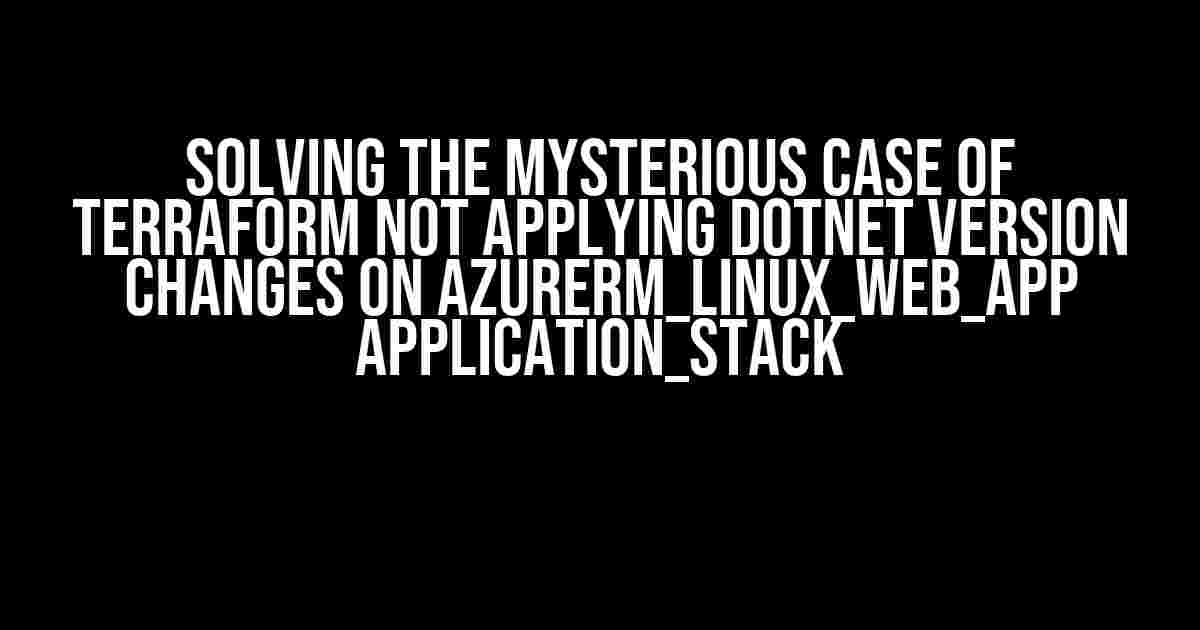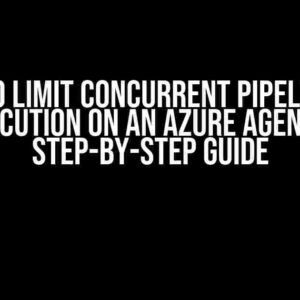Are you tired of scratching your head, wondering why Terraform is not applying the dotnet version change on your azurerm_linux_web_app application_stack? You’re not alone! This pesky issue has been driving many developers crazy, but fear not, dear reader, for we’re about to embark on a thrilling adventure to resolve this enigma once and for all!
- The Problem: A Symptoms-Only Diagnosis
- The Investigation Begins: Understanding Terraform and Azure Web Apps
- The Culprit: Terraform’s Refresh Behavior
- The Solution: Forcing Terraform to Update the application_stack Resource
- Terraform Best Practices: Avoiding Future Headaches
- The Verdict: Terraform is Not the Enemy
The Problem: A Symptoms-Only Diagnosis
Before we dive into the solution, let’s take a step back and examine the symptoms of this issue. You’ve likely encountered the following scenarios:
- Your Terraform configuration file specifies a different dotnet version for the azurerm_linux_web_app application_stack.
- You’ve ran
terraform applymultiple times, but the dotnet version remains unchanged. - You’ve verified that the Terraform state file reflects the updated dotnet version, but the Azure portal still displays the old version.
The Investigation Begins: Understanding Terraform and Azure Web Apps
To grasp the root cause of this issue, we need to understand how Terraform interacts with Azure Web Apps and the application_stack resource. Let’s break it down:
Terraform uses the AzureRM provider to create and manage Azure resources, including Web Apps. When you create an azurerm_linux_web_app resource, Terraform sends a request to Azure to create a new Web App with the specified configuration.
The application_stack resource is a sub-resource of azurerm_linux_web_app, which defines the runtime stack for the Web App. In this case, we’re concerned with the dotnet version.
Terraform’s Internals: How State Files and Refreshes Work
To understand why the dotnet version change isn’t being applied, we need to dive deeper into Terraform’s internals. When you run terraform apply, Terraform performs the following steps:
- Reads the Terraform configuration file and creates an execution plan.
- Compares the execution plan with the current state file to determine the changes needed.
- Applies the changes to the Azure resources using the AzureRM provider.
- Updates the state file to reflect the new resource state.
Terraform’s state file is a JSON file that stores the current state of your infrastructure. When you run terraform apply, Terraform refreshes the state file by re-reading the current state of the Azure resources. This ensures that the state file remains up-to-date and accurate.
The Culprit: Terraform’s Refresh Behavior
Now that we’ve covered the basics, let’s get to the root cause of the issue. The problem lies in Terraform’s refresh behavior when updating the application_stack resource. When you update the dotnet version in your Terraform configuration file, Terraform doesn’t automatically refresh the application_stack resource during the terraform apply process.
This means that despite updating the state file, the actual dotnet version on the Azure Web App remains unchanged. It’s as if Terraform is saying, “Hey, I’ve updated the state file, but I’m not going to bother updating the actual resource… this time.”
The Solution: Forcing Terraform to Update the application_stack Resource
Now that we’ve identified the culprit, let’s get to the solution. To force Terraform to update the application_stack resource, you need to use the taint command. Yes, you read that right – taint!
The taint command tells Terraform to mark a specific resource as “tainted,” which means Terraform will recreate the resource during the next terraform apply run. In this case, we’ll taint the application_stack resource to force Terraform to update it with the new dotnet version.
Step-by-Step Instructions
Follow these steps to resolved the issue:
- Update your Terraform configuration file to specify the new dotnet version:
resource "azurerm_linux_web_app" "example" {
// ...
application_stack {
// Update the dotnet version
dotnet_version = "6.0"
}
}
Terraform Best Practices: Avoiding Future Headaches
To avoid running into similar issues in the future, follow these Terraform best practices:
- Use the
taintcommand judiciously to force Terraform to update resources that aren’t being updated automatically. - Regularly run
terraform refreshto ensure the state file is up-to-date. - Verify that the Terraform state file reflects the actual resource state.
- Keep your Terraform configuration file organized and easy to read.
The Verdict: Terraform is Not the Enemy
In conclusion, Terraform is a powerful tool that can sometimes behave mysteriously. But with a deep understanding of its internals and a dash of creativity, we can overcome even the most perplexing issues. By following the instructions outlined in this article, you should be able to resolve the dotnet version change issue with azurerm_linux_web_app application_stack.
Remember, Terraform is your friend, and with a little patience and persistence, you can conquer even the most daunting challenges in the world of infrastructure as code.
| Terraform Command | Description |
|---|---|
terraform init |
Re-initializes the Terraform working directory. |
terraform taint |
Marks a resource as “tainted” to force recreation during the next terraform apply run. |
terraform apply |
Applies the changes to the infrastructure based on the Terraform configuration file. |
terraform refresh |
Updates the Terraform state file to reflect the current state of the infrastructure. |
Frequently Asked Questions
If you’re having trouble with Terraform not applying the dotnet version change on azurerm_linux_web_app application stack, we’ve got you covered! Check out these frequently asked questions and get back to deploying your application stack in no time.
Why is Terraform not applying the dotnet version change on my azurerm_linux_web_app?
This could be due to the fact that Terraform is not detecting the change in the dotnet version. Try running `terraform refresh` to re-sync the state before applying the changes.
I’ve tried `terraform refresh`, but the issue persists. What’s next?
In that case, check if you’ve specified the correct dotnet version in the `application_stack` block of your Terraform configuration. Make sure the version is compatible with your Azure Linux Web App.
I’ve double-checked my configuration, and everything looks good. Any other possible causes?
Yes, another common issue is that the Azure Linux Web App might be stuck in a failed state. Try stopping and restarting the app service plan to see if that resolves the issue.
I’m using Terraform 0.14.x, and I’ve noticed that the `dotnet_version` field is deprecated. What’s the alternative?
You’re correct that the `dotnet_version` field is deprecated in Terraform 0.14.x. Instead, use the `dotnet_framework_version` field to specify the dotnet version for your Azure Linux Web App.
I’ve tried all of the above, and the issue still persists. Where can I seek further help?
Don’t worry, we’ve got you covered! You can seek further help on the Terraform community forums, Terraform GitHub issues, or even create a new issue on the Azure Provider GitHub repository. The community is always happy to help.


